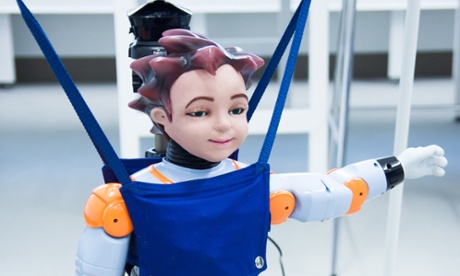
From techno-sheepdogs to android bedfellows, the promise of robotics and the lure of artificial intelligence appears to know no bounds. But will we ever be able to have a proper natter with a robot? And just what will they look like? Now is your chance to find out.
Experts will be sharing the latest news in a series of talks and demos under the banner of the New Age of Robotics as part of Sheffield’s wide-ranging Festival of the Mind, which starts on 18 September.
“Science fiction robots are very different from real robots, and we want to show people what technologies are available now, what might be round the corner, and discuss the societal issues around those,” says Tony Prescott, director of the Sheffield Centre for Robotics and professor of cognitive neuroscience.
A collaboration between Sheffield University and the city, the festival will delve into the pros and cons of emerging technology. Among the talks, Professor Adrian Cheok from City University London will share a romantic vision of the future in his adults-only “X lecture”, explaining how “digital intimacy” could let us share physical sensations, from hugs to smells. His team has developed the “Kissenger”, a method for transmitting a long-distance smooch using a pair of devices that capture and replicate lip movement.
More cautious about embracing a techno-future, Noel Sharkey, professor of artificial intelligence and robotics at Sheffield University and co-founder of the International Committee for Robot Arms Control, will explore the potential dangers of robo-warfare. “Robot weapons pose a new and terrifying threat to humanity,” he says. “They will select their own targets and attack them without human involvement.”
More likely to amuse than unnerve, however, are two robots on show as part of the festival’s interactive exhibition. Able to display a range of emotions, the state-of-the-art humanoid, Zeno, is keen to challenge visitors to a game of Simon says, while Paro, a robo-seal developed in Japan, showcases one of the burgeoning applications for robots in health and social care. Prescott explains: “In our research we are looking at how useful this is – how effective it might be – in actually calming down people with Alzheimer’s, which is one of the applications. And we’re looking at how people with different personalities might respond to those kinds of robots.”
There’s little doubt that as technology develops so too will the ethical and social dilemmas. But while some view a future “singularity” – the point where artificial intelligence exceeds our own – as spelling the end of mankind, Prescott has a more sanguine outlook. “I think our job as technologists is to think about those futures and to see what we can start to do now to ensure that we end up with the more optimistic scenarios being realised and avoiding the dangerous ones.
“This Festival of the Mind is one small part of that – engaging with people about things they are worried about, and then, in our research programmes, making sure that we anticipate those things.”

